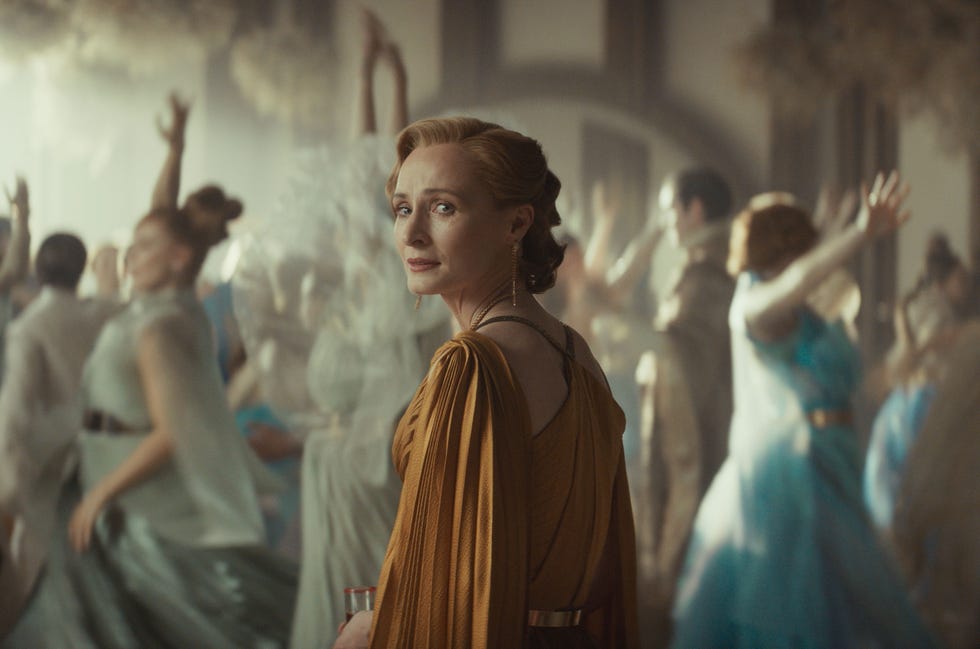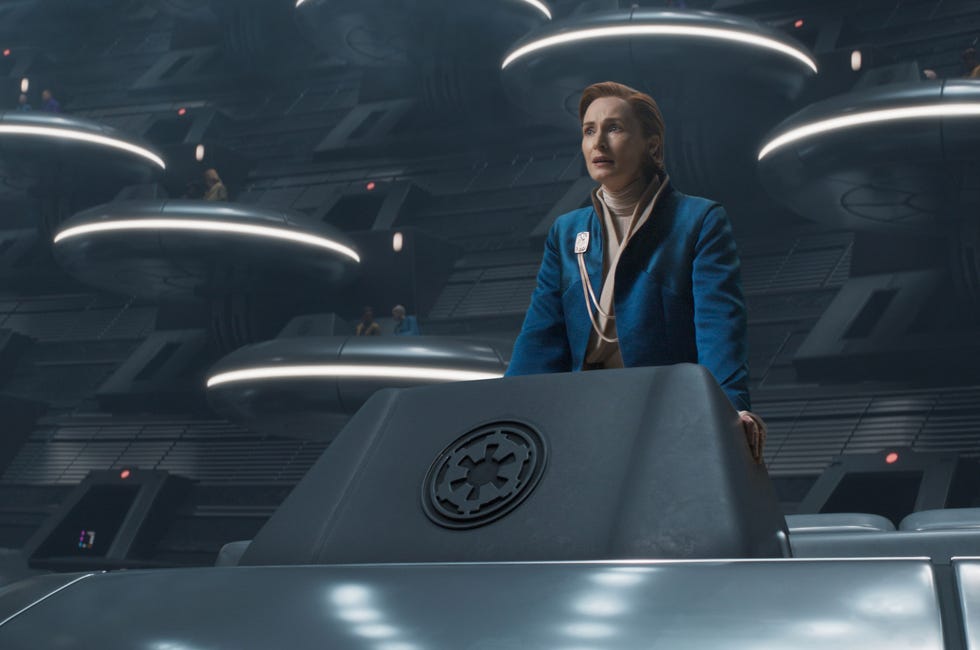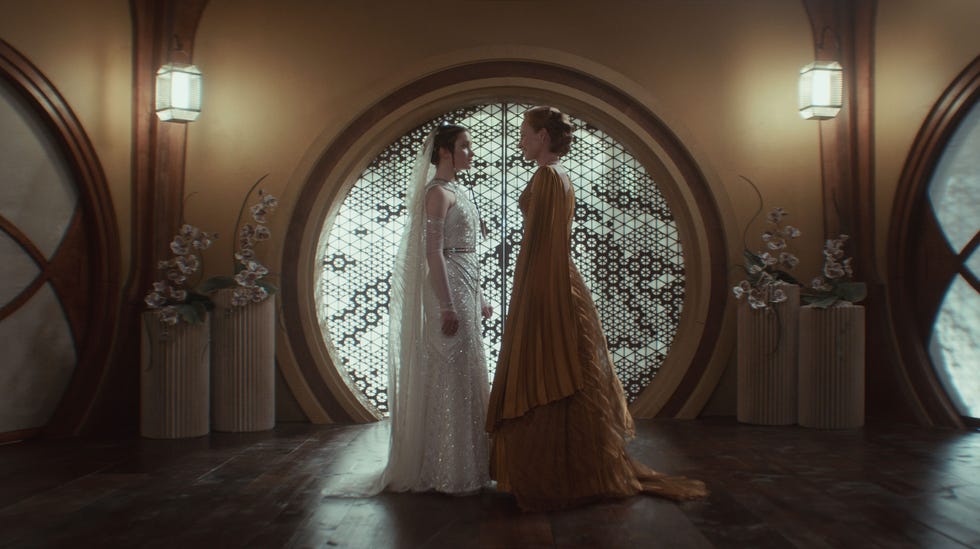Why Is <em>Andor</em> So Special? Ask Mon Mothma Herself, Genevieve O’Reilly.

Where most Star Wars fans saw a joke, Genevieve O'Reilly saw pain. In the 1983 Star Wars sequel Return of the Jedi, actress Caroline Blakiston played Rebel Alliance leader Mon Mothma, and one of her most famous lines—"Many Bothans died to bring us this information," referring to the existence of a second Death Star—is spoken with a kind of ethereal detachment. Like a ghost to a crowded room.
But with the Reddit peanut gallery, the line's convenient and hurried introduction of the movie's main threat is roasted to no end. After all: Who are Bothans? And how many actually died? But O'Reilly never laughed. "Her sacrifice has many rivers," she tells me.
O'Reilly's journey into Star Wars began over 20 years ago, when the now 48-year-old Irish Australian actress was cast as Mon Mothma in the 2005 finale to the prequel trilogy, Revenge of the Sith. Eager to excel in what was then the biggest movie of her budding career, O'Reilly studied Blakiston's earlier performance. "I remember being particular, wanting to be true to the performance Caroline had given," she recalls over Zoom. "I wanted to get the articulation of her voice. I wanted to understand how she might have held herself. How she might have felt."
What O'Reilly felt was a wealth of regret in a single sentence. "That famous line, 'Many Bothans died,' there was a deep pain within her, and I was curious what that pain was. Through Andor, we have learned that there are rivers of pain within her, a stoicism and a courage and a bravery to bear herself and use her voice."
O'Reilly's own speaking parts were cut from Revenge of the Sith. But over a decade later, she returned as Mon for the 2016 spin-off Rogue One: A Star Wars Story. In 2022, she returned yet again for Andor, the acclaimed Rogue One prequel series on Disney+. While the show centers on reluctant revolutionary Cassian Andor (Diego Luna), O'Reilly plays a major role as Mon Mothma organizes a clandestine rebellion against the Galactic Empire from her posh political office suite. Through her, Andor reveals the deeply personal cost of revolutions.
"She's a courageous woman. Any political victory requires deep personal sacrifice," O'Reilly adds. "She's not Luke Skywalker. She doesn't wield a weapon. Her only weapon is her voice. It's when she chooses to use that weapon that she's effective for the Rebellion. Her bravery is in her diplomacy and how she chooses to hold herself."
With the second and final season of Andor now on Disney+, O'Reilly doesn't need to hold back spoilers anymore. In a wide-ranging interview with Esquire, O'Reilly unpacks the heart and soul of Mon Mothma and her most important scenes in season 2–from her speech on the senate floor to her moves on the dance floor.
This interview has been edited and condensed for clarity.

Genevieve O'Reilly has played Senator Mon Mothma for the Star Wars franchise on and off since Revenge of the Sith in 2005. "Playing characters again and again is continually revelatory if the writing is good," she says.
ESQUIRE: Now that Andor is over, what is your full understanding of Mon Mothma?
GENEVIEVE O'REILLY: She's an extraordinary woman. She has been revealed to me through Andor. Season 1 opened her up, but season 2 was curious about her—her strengths, her weaknesses, her fears, her drive—in a way I had never known. She's a socially conscious woman. She's grown up in a gilded privilege that she finds contradictory with her own ethos. She has navigated corners and crevices to grow into the woman she wants to be. Sometimes we think of revolution from the perspective of the working class. For rebellions to be effective, you need people in power speaking for you as well. I learned that about her in a way that I didn't before. She needed to be the voice of the people.
She strikes me as someone who feels suffocated by tradition and ceremony.
Andor revealed she grew up in a deep orthodoxy and with all of those confines an orthodoxy requires. I understood her journey to being a senator much clearer after playing within the idea of what Chandrila was, and [showrunner Tony Gilroy's] dive into the culture and traditions of Chandrilans. That's what I was talking about before: She navigated her way out of that, through politics, to being able to release herself from the confines of those traditions. Traditions can be helpful and comforting but also confining. Talking about the rituals of the senate, she was using the tradition of the senate to push back against the Empire.
Let's rewind to 2004, when you're on the set of Revenge of the Sith. What were your feelings on Mon Mothma back then? Did you have any notion that Revenge of the Sith wasn't the end of you as Mon Mothma?
I had no idea. It was all so new to me. I was a wide-eyed young actor thrilled to step into this well-oiled machine. To share scenes with Natalie Portman and Jimmy Smits and Anthony Daniels. Even to witness a blue-screen soundstage. I was so curious and thrilled. And I was cut! I just popped it in my bag and took the experience with me. We're often journeyman actors, and that was a really great experience, but I had no inclination that I would ever come back.
She needed to be the voice of the people.
From Revenge of the Sith to Andor, you've been all over the place in Mon Mothma's timeline. As an actor, how do you understand a character through a nonlinear lens?
Playing characters again and again is continually revelatory if the writing is good. With new scenarios and new relationships, they unpeel like an onion. What was interesting was filming Andor, a prequel to Rogue One, you might think that that would be stymieing because something exists in the future. But it wasn't at all. It was liberating. It allows for swings and choices that are perhaps bigger because you know where you end up. I remember being thrilled with Michael Wilkinson's costume designs and Emma Scott's hair and makeup—the bravery that you can start somewhere different. That allowed my own choices to be wider and to explore a psychology that is not what Rogue One was.
You said you were always curious where Mon Mothma's anguish came from. Which moments from Andor might be the source?
There are many moments. The relationship with her daughter is a deep source of pain. You get an idea of that in episode 3 when she reveals to her daughter that her mother had sent her into a loveless marriage and that her mother was drunk at her wedding. And then the daughter stabs her with, "I wish you were drunk." To give her daughter an out—to say, "You don't have to make the mistakes I made, you can get out of this"—and then for her daughter to use that orthodoxy as a knife, she bled from that.
Tell me everything about shooting Mon's speech on the senate floor. It's one of the best moments in the whole show, and you're the center of it.
I remember that day so well, because that scene is the fulcrum of the woman. Everything about her rests on [that]. Dan Gilroy wrote episode 9, and Tony is a master creator. They made space for Mon Mothma in that speech. They not just acknowledged her voice—they gave her voice. What was wonderful was that it was written as a speech. As an actor, the availability of fear and nervousness already exists in my body. So it allowed for synergy of character and actor. Also very special for me was that it was in front of our entire crew. They're overworked and overtired, and they stood there. There was this beautiful relationship—they're the people you're fighting for.
On Andor, we film on big sets where everything is created by artists and carpenters. We get to live it. Like those wedding sets. We can touch them. Feel them. It's magical, the sets in Andor. But the senate is not. The senate is green screen. So that's a different day. You climb up a ladder into this pod in the middle of this cavernous green. It's a lonely day as an actor.
It's a moment in Andor that is expressly, explicitly political and feels eerily real.
That speech could have existed many times in our history around the world. Now, 100 years ago, 500 years ago. Empire has roots all through humanity. What was different was that the filmmakers gave it to the woman to give. It's not something we see often.

"We think we're so much cleverer and more brilliant than we were 70-something years ago, but we're not," O'Reilly says. "We're the same beings following the same patterns. But if we tell stories well, we can recognize ourselves."
How might stories like Star Wars, and Andor specifically, instruct us on understanding political villainy?
Science fiction is at its best as an exploration of our humanity. Tony has been honest where he plucked a lot of the ideas for this from. It is all through lived history. What is clear is how cyclical we are as human beings, how these ideas come up again and again. We excuse ourselves because we think we're exceptional. We think we're so much cleverer and more brilliant than we were 70-something years ago, but we're not. We're the same beings following the same patterns. But if we tell stories well, we can recognize ourselves. I am hopeful that through the gauze of Star Wars and Andor people can see this is a very beautifully complicated human story.
Another pivotal moment for Mon Mothma is when she dances at her daughter's wedding in deep emotional distress. How did you nonverbally communicate her extreme turmoil?
It took many days to film. We filmed a lot of that whole wedding sequence in the lead-up to the strike. We didn't get to the dance [the first time]—the strike was called the day before. In fact, the last scene we shot was the scene with Mon and Luthen just before it. The strike was called and we had months off. When we came back, I had to film another few pieces, but that was left. My last day on Andor was that big dance sequence.
Tony wanted to get inside her head. How do you create [Mothma's struggle] with movement? The idea of chaos, but the chaos is interior? It's a beautiful, dramatic irony, the way that is all set up, because you have what looks from the outside a vibrant dance. But if you understand the character and the complexity of what's just happened, you share this trauma abandonment. It's to stop herself from screaming.
We shot that with Ariel Keiman, our director, and Christophe Nuyens, our DP. They used a lot of concentric circles. It was beautiful because it was a dance, but it was a dance between myself and our DP working together. It was important for me, because I wanted to see Mon Mothma physical in a way we had never seen her. I wanted to wrestle her out of her linear psychology and break the mold. We spent the day doing that. The joy that gave me to explore her. We all carry with us many faces of our pain. I loved the dramatic irony of that.

"The relationship with her daughter is a deep source of pain," the actor observes. "She bled from that."
In interviews like these, journalists ask something to the effect of "Would you come back for a sequel?" And the answer is typically "Yes, if they'll have me." But you've been Mon Mothma for years, and you have returned. Considering that Mon's story still seems open-ended, I'm asking anyway: Would you come back as Mon Mothma?
There are always stories to tell. I never could have expected the reveal of character and of this woman Andor gave me. I'm humbled by my own ignorance to say: perhaps.
Have you ever met Caroline Blakiston?
It was just before Covid, at a hotel in London. She was coming in to have a meeting with George Miller. I happened to be there. She came in and she said, "You're Genevieve." And I said, "You're Caroline." We both hugged. George said, "What's going on?" We had to explain to him that I had the great fortune of playing the younger version of her. We told him the whole story. He couldn't believe it. I remember him taking a picture of us together. She was terribly gracious. It was a really special meeting, because she has had such a place in my head for years.
esquire





